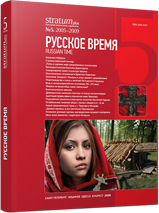Межплеменные пограничья в Брянском Подесенье: современное состояние вопроса
The Intertribal Borderlines in Bryansk Part of the Desna Basin: Modern Approaches to the Problem
Author(s): Evgenii A. Shinakov, Valerii N. GuryanovSubject(s): History, Archaeology, Middle Ages, 6th to 12th Centuries
Published by: Издательский дом Stratum, Университет «Высшая антропологическая школа»
Keywords: Intertribal Borderlines; Bryansk Region; Desna river basin; Vyatichi; Radimichi; Severyani; Krivichi
Summary/Abstract: The article treats correspondence of ethnocultural borderlines in Central (Bryansk) Desna region, introduced by V.V. Sedov (1982) with the same borderlines determined by modern methods of typology (including elements of correlative analysis), and contamination between ethnical and physical-geographical areas determined by numismatic methods. Ukrainian, Bryansk and some other archeologists have been conducting joint archeological excavations both in the Central Desna region and in the whole South-East of Rus over the last 25 years. The Central Desna region was the place of intercrossing borderlines of Romny culture, “the land of Rus”, Vyatichi, Radimichi, Severyani and Krivichi. The research yielded a very detailed and verified picture of contamination of borderlines of some “alliances of tribes” in this region.Compared to “Sedov’s borderline”, the area of Radimichi shrank in the west, yet it was a little extended to the north-east. The area of Romny culture remained practically the same as on Sedov’s map.The borderline of Krivichi was moved aside to the south, the area of Vyatichi shrank to the east of Bryansk and Karachev and the Bolva River. The area of Severyani was extended from Trubchevsk to the Navlya River and Bryansk.On the whole, V.V. Sedov’s conclusions were confirmed, but in some cases verified and corrected.
Journal: Stratum plus. Археология и культурная антропология
- Issue Year: 2009
- Issue No: 5
- Page Range: 576-588
- Page Count: 13
- Language: Russian
- Content File-PDF

